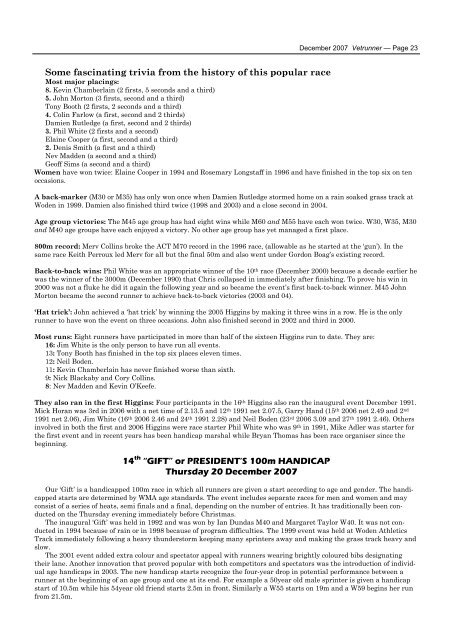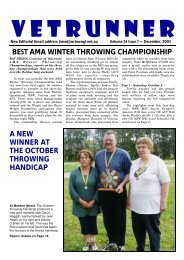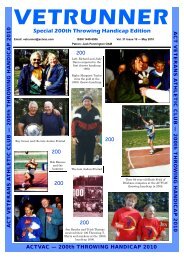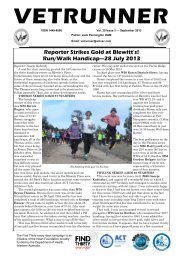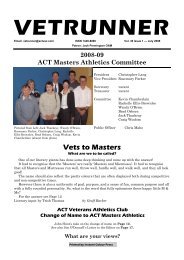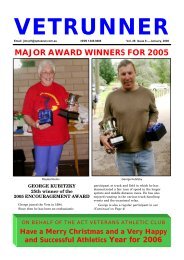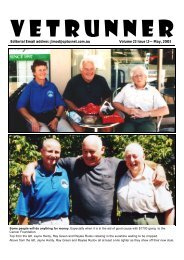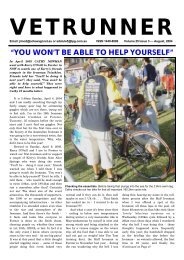Vetrunner December 2007.pub - ACT Veterans Athletics Club
Vetrunner December 2007.pub - ACT Veterans Athletics Club
Vetrunner December 2007.pub - ACT Veterans Athletics Club
You also want an ePaper? Increase the reach of your titles
YUMPU automatically turns print PDFs into web optimized ePapers that Google loves.
<strong>December</strong> 2007 <strong>Vetrunner</strong> — Page 23Some fascinating trivia from the history of this popular raceMost major placings:8. Kevin Chamberlain (2 firsts, 5 seconds and a third)5. John Morton (3 firsts, second and a third)Tony Booth (2 firsts, 2 seconds and a third)4. Colin Farlow (a first, second and 2 thirds)Damien Rutledge (a first, second and 2 thirds)3. Phil White (2 firsts and a second)Elaine Cooper (a first, second and a third)2. Denis Smith (a first and a third)Nev Madden (a second and a third)Geoff Sims (a second and a third)Women have won twice: Elaine Cooper in 1994 and Rosemary Longstaff in 1996 and have finished in the top six on tenoccasions.A back-marker (M30 or M35) has only won once when Damien Rutledge stormed home on a rain soaked grass track atWoden in 1999. Damien also finished third twice (1998 and 2003) and a close second in 2004.Age group victories: The M45 age group has had eight wins while M60 and M55 have each won twice. W30, W35, M30and M40 age groups have each enjoyed a victory. No other age group has yet managed a first place.800m record: Merv Collins broke the <strong>ACT</strong> M70 record in the 1996 race, (allowable as he started at the ‘gun’). In thesame race Keith Perroux led Merv for all but the final 50m and also went under Gordon Boag’s existing record.Back-to-back wins: Phil White was an appropriate winner of the 10 th race (<strong>December</strong> 2000) because a decade earlier hewas the winner of the 3000m (<strong>December</strong> 1990) that Chris collapsed in immediately after finishing. To prove his win in2000 was not a fluke he did it again the following year and so became the event’s first back-to-back winner. M45 JohnMorton became the second runner to achieve back-to-back victories (2003 and 04).‘Hat trick’: John achieved a ‘hat trick’ by winning the 2005 Higgins by making it three wins in a row. He is the onlyrunner to have won the event on three occasions. John also finished second in 2002 and third in 2000.Most runs: Eight runners have participated in more than half of the sixteen Higgins run to date. They are:16: Jim White is the only person to have run all events.13: Tony Booth has finished in the top six places eleven times.12: Neil Boden.11: Kevin Chamberlain has never finished worse than sixth.9: Nick Blackaby and Cory Collins.8: Nev Madden and Kevin O’Keefe.They also ran in the first Higgins: Four participants in the 16 th Higgins also ran the inaugural event <strong>December</strong> 1991.Mick Horan was 3rd in 2006 with a net time of 2.13.5 and 12 th 1991 net 2.07.5, Garry Hand (15 th 2006 net 2.49 and 2 nd1991 net 2.06), Jim White (16 th 2006 2.46 and 24 th 1991 2.28) and Neil Boden (23 rd 2006 3.09 and 27 th 1991 2.46). Othersinvolved in both the first and 2006 Higgins were race starter Phil White who was 9 th in 1991, Mike Adler was starter forthe first event and in recent years has been handicap marshal while Bryan Thomas has been race organiser since thebeginning.14 th “GIFT” or PRESIDENT’S 100m HANDICAPThursday 20 <strong>December</strong> 2007Our ‘Gift’ is a handicapped 100m race in which all runners are given a start according to age and gender. The handicappedstarts are determined by WMA age standards. The event includes separate races for men and women and mayconsist of a series of heats, semi finals and a final, depending on the number of entries. It has traditionally been conductedon the Thursday evening immediately before Christmas.The inaugural ‘Gift’ was held in 1992 and was won by Ian Dundas M40 and Margaret Taylor W40. It was not conductedin 1994 because of rain or in 1998 because of program difficulties. The 1999 event was held at Woden <strong>Athletics</strong>Track immediately following a heavy thunderstorm keeping many sprinters away and making the grass track heavy andslow.The 2001 event added extra colour and spectator appeal with runners wearing brightly coloured bibs designatingtheir lane. Another innovation that proved popular with both competitors and spectators was the introduction of individualage handicaps in 2003. The new handicap starts recognize the four-year drop in potential performance between arunner at the beginning of an age group and one at its end. For example a 50year old male sprinter is given a handicapstart of 10.5m while his 54year old friend starts 2.5m in front. Similarly a W55 starts on 19m and a W59 begins her runfrom 21.5m.


